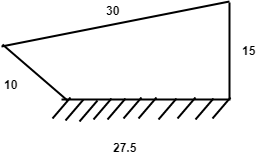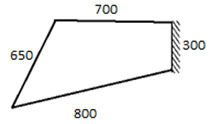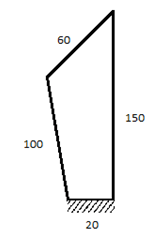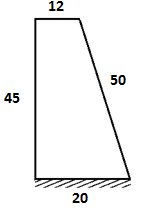1. What is the condition involved in Grashof’s law?
a) s+l≥p+q
b) s-l ≥ p-q
c) s+l≤p+q
d) s-l ≤ p-q
Explanation: According to Grashof’s law, in a four bar mechanism, the sum of the lengths of the shortest and the longest link should be less than or equal to the sum of the lengths of two remaining links for continuous relative motion between them.
Therefore, s+l≤p+q.
2. If Grashof’s law is not satisfied, no link will make a complete revolution relative to one another. True or False?
a) False
b) True
Explanation: According to Grashof’s law, in a four bar mechanism, the sum of the lengths of the shortest and the longest link should be less than or equal to the sum of the lengths of two remaining links for continuous relative motion between them. Thus, the given statement is false.
3. If the link next to the shortest link is fixed, what type of mechanism is obtained?
a) Double crank mechanism
b) Linkage is not planar
c) Double rocker mechanism
d) Crank rocker mechanism
Explanation: When the link next to the shortest link is fixed, the short link is able to rotate continuously and is called crank. The link opposite to it can only oscillate between limits and is called the rocker. Thus, the mechanism obtained is the crank rocker mechanism.
4. If the shortest link is fixed, what type of mechanism is obtained?
a) Double crank mechanism
b) Double rocker mechanism
c) Linkage is not planar
d) Crank rocker mechanism
Explanation: When the shortest link is fixed, the links adjacent to it rotate continuously and can be described as proper cranks. Thus, this mechanism is called as double crank mechanism.
5. If the link opposite to the shortest link is fixed, what type of mechanism is obtained?
a) Double crank mechanism
b) Linkage is not planar
c) Double rocker mechanism
d) Crank rocker mechanism
Explanation: When the link opposite to the shortest link if fixed, the shortest link is able to make a complete revolution but the two links adjacent to it oscillate between limits and are called rockers.
Thus, this mechanism is called as double rocker mechanism.
6. If the s+l=p+q, what is the type of linkage?
a) Trapezium
b) Parallelogram
c) Circular
d) Six bar
Explanation: According to the given condition, s+l=p+q i.e. the sum of the lengths of the adjacent sides are equal. Thus, the linkage has to be a parallelogram.
7. What type of mechanism is shown in the given diagram?
a) Double crank mechanism
b) Linkage is not planar
c) Double rocker mechanism
d) Crank rocker mechanism
Explanation: When the link next to the shortest link is fixed, the short link is able to rotate continuously and is called crank. The link opposite to it can only oscillate between limits and is called the rocker. In the given diagram, the link adjacent to the shortest link is fixed, thus crank rocker mechanism is obtained.
8. What type of mechanism is shown in the diagram given below?
a) Crank rocker mechanism
b) Double crank mechanism
c) Double rocker mechanism
d) Linkage is not planar
Explanation: When the shortest link is fixed, the links adjacent to it rotate continuously and can be described as proper cranks. In the given diagram, the shortest link is fixed, thus double crank mechanism is obtained.
9. What type of mechanism is shown in the diagram given below?
a) Double rocker mechanism
b) Double crank mechanism
c) Crank rocker mechanism
d) Linkage is not planar
Explanation: When s+l is not less than or equal to p+q, Grashof’s law is not satisfied and the linkage isn’t planar. According to the given figure, the Grashof’s law is not satisfied. Hence, the four bar linkage is not planar.
10. What type of mechanism is shown in the diagram given below?
a) Double rocker mechanism
b) Double crank mechanism
c) Crank rocker mechanism
d) Linkage is not planar
Explanation: When the link opposite to the shortest link if fixed, the shortest link is able to make a complete revolution but the two links adjacent to it oscillate between limits and are called rockers.
Here, the link opposite to the shortest side is fixed. Thus, the mechanism obtained is double rocker mechanism.